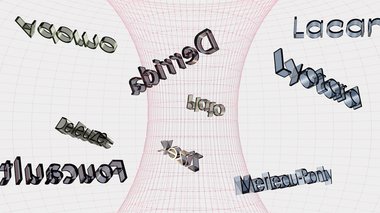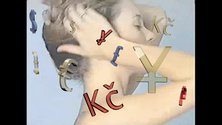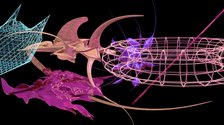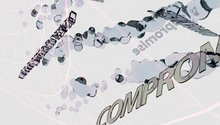John Hurrell – 11 November, 2013
Although the presence of the theory ‘brands' adds to the sense of the video being a critique of the web as a dominant perpetuator of consumerism, their presence is also implied to be part of the problem, especially because of the knowledge economy, the high number of universities competing for post-grad ‘buyers', and the popular belief that advanced education will guarantee university jobs that bring for suitably erudite artists wealth, health and happiness.
Sorawit Songsataya has four videos on the Circuit site and several other shorter ones on Vimeo. At the Audio Foundation his more recent project involves a projected 5 minute long video loop entitled Jacques, possibly after Jacques Lacan, one of several French thinkers (and Zizek and Plato) whose names float in 3D fonts in some of the computer graphic sections of the work. With mingled chunks of appropriated imagery from advertising (hair shampoo), Hollywood (Top Gun with Tom Cruise and Kelly McGillis) and music videos (Roxy Music’s Slave to Love), the dominant trope seems to be carcinogenic or fungal growths as a signifier for Capitalism’s ethos of penetrating the Subject via its ubiquitous mechanisms of desire.
Occasionally in this video indications of resistance surface in the form of the opposing stated terms of compromise and intransigence and an alluded to oscillation between the two. With the downloaded advertising, a flirtatious pretty girl is accompanied by various signs for global currency, anticipating future fiscal transactions. The dreamily hypnotic sound track and interwoven graphics of intricate girderlike or viral tumbling forms hold your attention. The addictive properties of consumerism are alluded to with a young woman talking about heroin chic and financial desperation while incessant images of glamorous women are compared to a fecund-looking stone Neolithic goddess.
Videos like Songsataya’s are these days commonplace with their preoccupation with cyberspace, computer graphics and a vast variety of available overlapping and interconnected moving image and sound technologies. For such practices galleries seem redundant, unless perhaps the artists provide some salient sculptural component, added scale in spectacle, or some variety of content that is of specific interest to museum attending communities. The floating names of famous writers (in 3D fonts) look out of date now, with no mention of more recent figures like Ranciere, Badiou or Agamben. Perhaps (with the show’s title) this is intended and a specific reference to Lacan and the tradition he is part of.
Although the presence of the theory ‘brands’ adds to the sense of the video being a critique of the web as a dominant perpetuator of consumerism, their presence is also implied to be part of the problem, especially because of the knowledge economy, the high number of universities competing for post-grad ‘buyers’, and the popular belief that advanced education will guarantee university jobs that bring for suitably erudite artists wealth, health and happiness.
This Audio Foundation show is also a good reminder that many of the contributors to exhibitions like say Natasha Conland’s current Freedom Farmers at Auckland Art Gallery don’t come from nowhere, that ‘activist’ or ‘eco’ artists are such for good reason, and that alternative ‘neo-hippie’ life styles are real, very feasible possibilities.
John Hurrell






 Two Rooms presents a program of residencies and projects
Two Rooms presents a program of residencies and projects Advertising in this column
Advertising in this column



This Discussion has 0 comments.
Comment
Participate
Register to Participate.
Sign in
Sign in to an existing account.